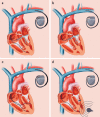Comparison of left ventricular and biventricular pacing: Rationale and clinical implications
- PMID: 31475952
- PMCID: PMC6735437
- DOI: 10.14744/AnatolJCardiol.2019.35006
Comparison of left ventricular and biventricular pacing: Rationale and clinical implications
Abstract
Cardiac resynchronization therapy constitutes a cornerstone in advanced heart failure treatment, when there is evidence of dyssynchrony, especially by electrocardiography. However, it is plagued both by persistently high (~30%) rates of nonresponse and by deterioration of right ventricular function, owing to iatrogenic dyssynchrony in the context of persistent apical pacing to ensure delivery of biventricular pacing. Left ventricular pacing has long been considered an alternative to standard biventricular pacing and can be achieved as easily as inserting a single pacing electrode in the coronary sinus. Although monoventricular left ventricular pacing has been proven to yield comparable results with the standard biventricular modality, it is the advent of preferential left ventricular pacing, combining both the powerful resynchronization potential of multipolar coronary sinus and right-sided electrodes acting in concert and the ability to preserve intrinsic, physiological right ventricular activation. In this review, we aim to present the underlying principles and modes for delivering left ventricular pacing, as well as to highlight advantages of preferential over monoventricular configuration. Finally, current clinical evidence, following implementation of automated algorithms, regarding performance of left ventricular as compared with biventricular pacing will be discussed. It is expected that the field of preferential left ventricular pacing will grow significantly over the following years, and its combination with other advanced pacing modalities may promote clinical status and prognosis of patients with advanced dyssynchronous heart failure.
Conflict of interest statement
Figures

References
-
- Bristow MR, Saxon LA, Boehmer J, Krueger S, Kass DA, De Marco T, et al. Comparison of Medical Therapy, Pacing, and Defibrillation in Heart Failure (COMPANION) Investigators. Cardiac-resynchronization therapy with or without an implantable defibrillator in advanced chronic heart failure. N Engl J Med. 2004;350:2140–50. - PubMed
-
- Cleland JG, Daubert JC, Erdmann E, Freemantle N, Gras D, Kappenberger L, et al. Cardiac Resynchronization-Heart Failure (CARE-HF) Study Investigators. The effect of cardiac resynchronization on morbidity and mortality in heart failure. N Engl J Med. 2005;352:1539–49. - PubMed
-
- Birnie DH, Tang AS. The problem of non-response to cardiac resynchronization therapy. Curr Opin Cardiol. 2006;21:20–6. - PubMed
-
- Chung ES, Leon AR, Tavazzi L, Sun JP, Nihoyannopoulos P, Merlino J, et al. Results of the Predictors of Response to CRT (PROSPECT) trial. Circulation. 2008;117:2608–16. - PubMed
-
- Gerber TC, Nishimura RA, Holmes DR, Jr, Lloyd MA, Zehr KJ, Tajik AJ, et al. Left ventricular and biventricular pacing in congestive heart failure. Mayo Clin Proc. 2001;76:803–12. - PubMed
Publication types
MeSH terms
LinkOut - more resources
Full Text Sources
Medical

